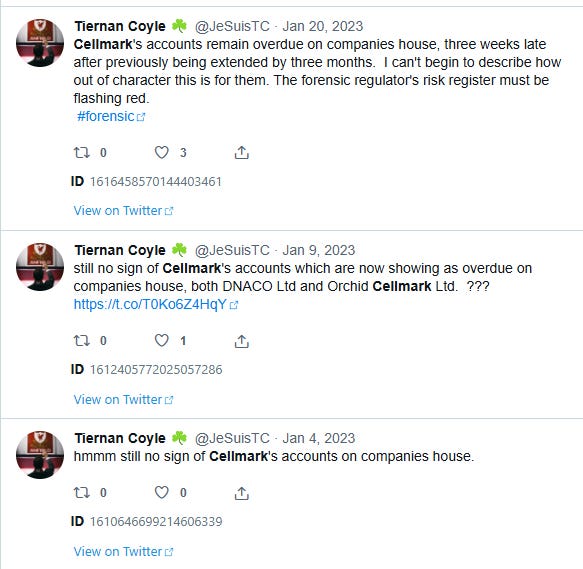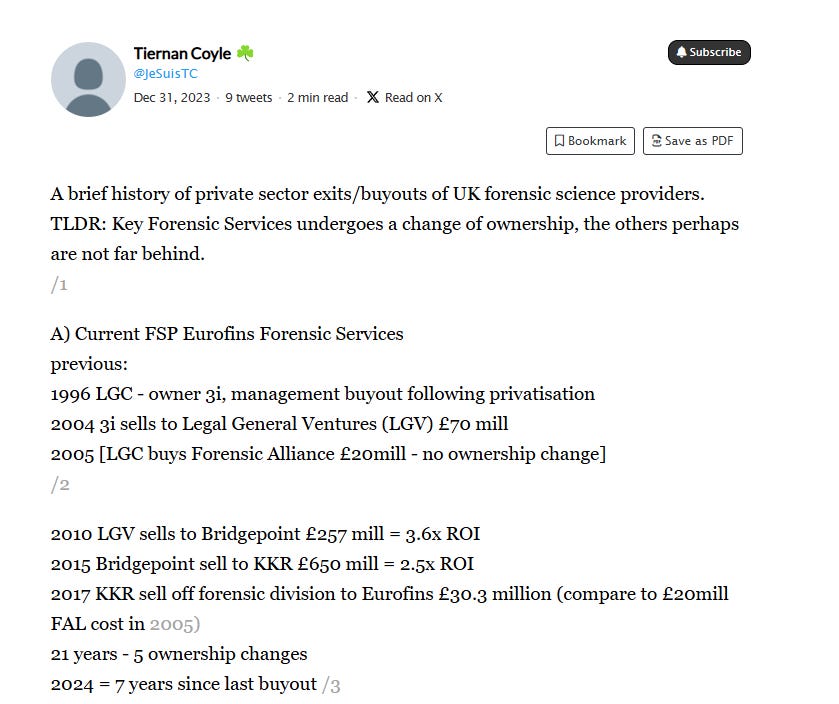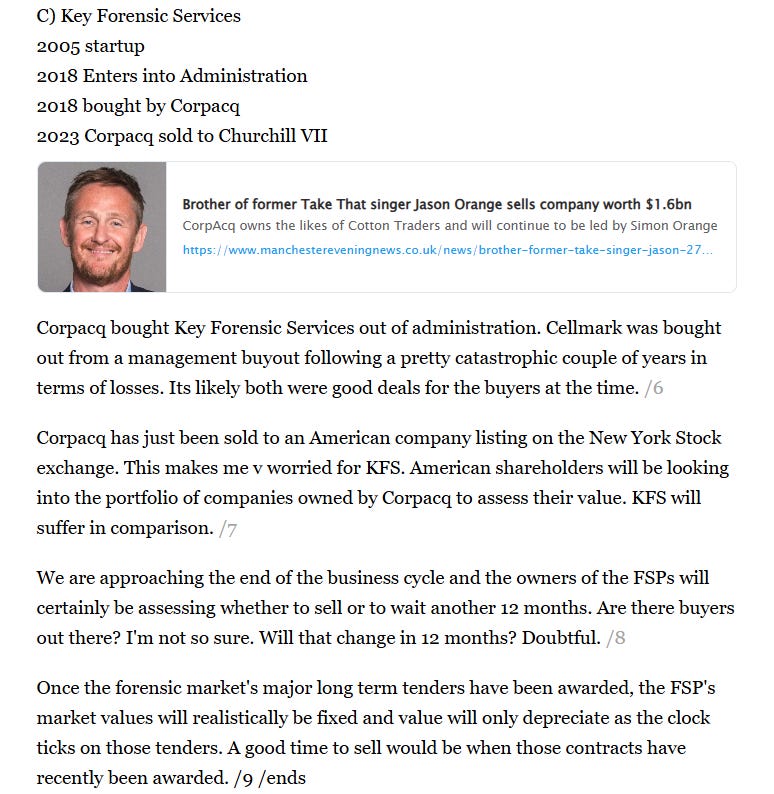2021 - 2024 Cellmark Forensic Services in difficulty
Cellmark, such a consistent, and reliable company in the past, was starting to behave oddly.
Post 2019 the forensic marketplace has remained on a knife-edge. With support from the UK Government for all private companies during the pandemic, and the pivot by some of these companies to providing Covid PCR testing, it made it increasingly difficult to assess precisely what was going on behind the scenes and what effects, if any, the price rises agreed by the police were having to stabilise the market.
Following the management buyout from Labcorp, Cellmark Forensic Services was the brand, but the legal entities behind that were Orchid Cellmark Ltd and DNACO Ltd. DNACO Ltd was a company set up by the directors to purchase Orchid Cellmark Ltd from Labcorp and thus could be considered the parent company. Both produced their own accounts as required under law, but with Orchid Cellmark Ltd representing a huge portion of the company’s revenue it was the driving force behind the group.
Whilst on paper nothing much had changed for Cellmark, they were led by the same people that had seen the ownership of Cellmark change hands several times over the course of many years, from Astra Zeneca to Orchid to Labcorp and were more than capable of making Cellmark a success. Their scientific base, their staff were world class at what they did. I know this because I was fortunate to work with them when my own company was a sub-contractor to them from 2006-2015. I hold them in very high regard and still do.
But, there was one key challenge for them. They no longer had a big parent company that could provide a source of funding to help them navigate periods where cash flow got tricky, and in this forensic marketplace, cash flow gets tricky for all providers 24/7. For funding they were now at the mercy of the financial markets, not too bad a place to be when interest rates are next to zero, central banks are printing money and money is cheap and plentiful, but an awful place to be if the world is emerging from the pandemic to face huge inflation problems, central banks have to catch up fast becasue they failed to act quickly enough and then……Russia invades Ukraine and the UK energy market disintegrates.
Police don’t pay quickly, all the costs are upfront, there was no allowance for inflation and huge penalities if turn-round-times were missed. If the forensic science providers missed their turn-round times they would have to pay the police a massive fine relative to the revenue for the analysis. Mark Pearse, CEO of Eurofins Forensic Services, rightly called these “toxic conditions” when describing them to the House of Lords:
Dr Mark Pearse: Somebody mentioned monopsony earlier. That is certainly the word that I would use. To be clear on these toxic terms and conditions, I guess it is typical of public sector tendering that we are talking by and large of zero indexation (with our wage costs going up and the cost of accreditation having gone up as standards are rightly raised by the regulator), and service credits, which are penalties on delivery times and vary according to contracts. When you add up service credits and indexation on top of falling prices you end up with what I call an unsustainable toxic set of conditions.
Turn-round-times requirements that became increasingly arbitrary and served no purpose for the criminal justice system because the forensic science providers would kill themselves trying to get fast results to police forces, only for their report to languish on the desk of police officers for weeks or months before they would act on them. There is an argument that the toxic terms and conditions were designed purely to claw back money to police forces. The private forensic science providers must have felt like they were partnering with Paulie from Goodfellas with revenue coming in one door of their restaurant and out the other.
But what of Cellmark, well they were always so prompt with publishing their financial accounts. Always on time. Every year. Until they weren’t.
Company accounts for the previous financial year are ususally published within 9 months of end of that financial year. Having an interest in the financial health of private forensic science providers, it was something I kept an eye on. I mentioned this on twitter:
I no longer have access to my twitter account having left the platform and the twitter archive I downloaded doesn’t allow access to threaded tweets below the headline tweet for some reason, but I wasn’t overly concerned that Cellmark’s accounts were late. In fact I gave them more than the benefit of the doubt. With hindsight, I regret that somewhat. One of my reasons for not being overly concerned was the upbeat message from the previous year published in the accounts of 2020.
The thing about private companies and management of them is this: for the outside observer you don’t learn much when things go well for a company. No-one is that bothered when profits are good, companies are growing and share prices are rising. You learn everything about them when times are bad.
By the end of January though, I was getting concerned.
When accounts for 2021 were finally published in May 2023, they had returned to losses and alarmingly, even though they were yet to publish the accounts for 2022, they were already describing that year as ‘challenging’. The drop in volumes of submissions a key component.
The directors go further in their review, “a challenging year in 2022” translating into “more significant losses”. The long term message, however, was one of positivity. The difficulty for the target audience for these comments was, now that you’ve published these accounts so late, can we really trust what you are saying to us?
Whilst the company had the benefit of knowing precisely the state of the business in May 2023; bankers, suppliers, creditors didn’t have that luxury and if they hadn’t investigated the situation when the company accounts became overdue (a red flag for all businesses), this set of accounts may have given them cause to do so now.
Things were about to get a lot worse. My posts on twitter and linkedin about the accounts of private forensic science providers were starting to gain traction and I began receiving private messages from a variety of sources with information regarding Cellmark.
Jungle drums may be telling the truth or maybe not and I had no way of knowing the difference from the outside. Journalists were asking me if I could corroborate the information they had received, tales of delayed payments to suppliers and staff, stocks of critial laboratory reagents running out, none of which I could help corroborate. All I could say was how out of character it was for Cellmark to publish their accounts so late, but that perhaps it was a one-off. Whilst very alarmed by what I was hearing, from my point of view all I could see were good people under immense pressure, doing everything they could to keep their business going, protecting jobs for their staff. I hoped that they would return to their previous behaviours asap and publish their accounts on time. But things were about to get worse.
December 2023 and I realised that we were at the end of the private forensic provider business cycle - from twitter:
By the time Cellmark published their accounts for 2022, in May of 2024 it was obvious why Cellmark may have wished to keep those results under wraps for as long as they possibly could.
Huge, huge loss. Just short of its record loss in 2018 that triggered Labcorp’s exit. Not only that, but 2023 was a loss too, although no sign of those accounts either. Another postive spin on things from the directors but after the previous year’s positive spin, what are interested parties supposed to do with this? It looked like the end for Cellmark.
In July 2024 the UK Competition and Markets Authority (CMA) announced that it had launched an investigation into Eurofins' takeover of the British company Cellmark, an operation it fears will have an adverse impact on competition in the market. Its findings would lay bare Cellmark’s financial troubles and how close it came to collapse which would have triggered an uncontrolled exit from the forensic science market wreaking havoc in the criminal justice system.


















